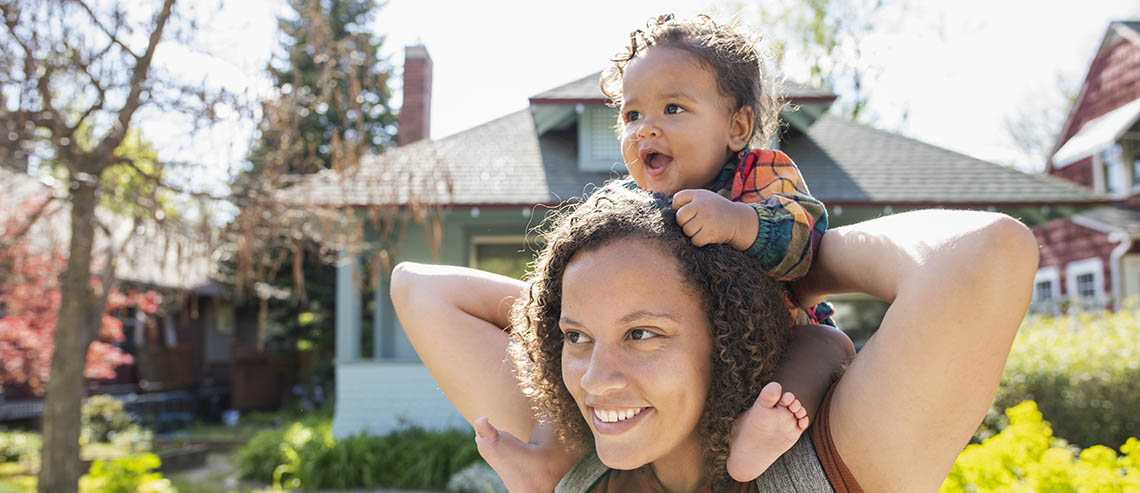
Earn cash back
after close!
With Home Connect, you could earn $350 to $9,500 cash back after close.
Many people think purchasing their first home is financially out of reach. But in many cases, that’s not true. Today’s aspiring homebuyers have numerous options to make homeownership a reality. From government-sponsored homebuyer assistance programs to state initiatives, there are many ways to obtain down payment assistance, closing cost aid, lower interest rates and more.
Homebuyer Assistance Program Options
Here’s an overview of some of the homebuyer assistance programs available. Explore the criteria and see if you qualify.
Freddie Mac and Fannie Mae Support
Fannie Mae and Freddie Mac are government-sponsored entities (GSEs) that help to make mortgage loans more affordable for borrowers. They offer a variety of money-saving programs for homebuyers, including the following popular options.
Fannie Mae HomeReady®
Fannie Mae HomeReady® offers financing up to 97% loan-to-value (LTV) for a primary residence. This mortgage program is not restricted to first-time buyers and offers flexibility around income sources, down payments and mortgage insurance requirements. Homeownership education is a requirement of the HomeReady mortgage program.
Who is the HomeReady program best for?
- Borrowers with limited financial resources whose income does not exceed 80% of the area median
- Borrowers with limited cash to make a down payment
- Homebuyers who may have supplemental income from boarders or renters
Freddie Mac Home Possible®
Freddie Home Possible® offers qualified borrowers a 3% down payment financing option. The program also lowers mortgage rates for eligible homebuyers. First-time homebuyers must complete a homeownership education class.
Who is the Home Possible program best for?
- First-time homebuyers and low- and moderate-income borrowers whose annual income does not exceed 100% of the area median income or a higher percentage in designated high-cost areas
- Current homeowners looking to downsize
- Low- to moderate-income borrowers purchasing or refinancing a single-family residence, 2-4 unit property, condominium, co-op, manufactured housing (with certain restrictions) or a planned unit development property
Freddie Mac BorrowSmart®
Homebuyers who qualify for Home Possible may also meet the requirements for Freddie Mac BorrowSmart®, which provides $1,250 in assistance to income-qualifying borrowers, to be used towards the down payment or closing costs needed to finance a new home.* At least one occupant borrower must complete free pre-purchase counseling with the Homeownership Preservation Foundation (HPF).
Who is the Freddie Mac BorrowSmart® program best for?
- Borrowers with limited financial resources whose qualifying income falls within 50.01% and 80% of the area median income (AMI)
- First-time homebuyers or repeat homebuyers seeking to finance a primary residence who meet qualifying criteria
Fannie Mae 97% Loan-to-Value (LTV)
The Fannie Mae 97% LTV financing option allows borrowers to purchase a home with a down payment as low as 3%, or refinance an existing loan with an LTV as high as 97%.
Who is the Fannie Mae 97% LTV financing option best for?
- Homebuyers who exceed the HomeReady Mortgage income limit but still want a low down payment - at least one borrower on the loan must be a first-time homebuyer.
- Current Fannie Mae loan holders who wish to do a limited cash-out refinance that allows borrowers to cash out up to 2% of the new loan amount or $2,000, whichever is less - this type of refinance is designed to help borrowers who need a small amount of cash for unexpected expenses, such as home repairs or medical bills.
Freddie Mac HomeOne®
The Freddie Mac HomeOne® mortgage is a low down payment program available to qualified first-time homebuyers, no cash-out refinance borrowers and other homebuyers, regardless of income level or geographic location.
Who is the Freddie Mac HomeOne® mortgage best for?
- First-time homebuyers who have a 3% down payment but earn over the median income requirements set for the Fannie Mae HomeReady® or Freddie Mac Home Possible® programs. Only one borrower on the loan has to be a first-time homebuyer.
- Homeowners who wish to do a no cash-out refinance. Also known as a rate-and-term refinance, this may allow a borrower to lower their interest rate and payment and potentially eliminate mortgage insurance.
RefiNow™
RefiNow™ is a program for homeowners who want to decrease their monthly payments by refinancing to a fixed-rate mortgage at a lower rate.
Who is the RefiNow™ program best for?
- Homeowners with a Fannie Mae-owned mortgage
- Borrowers at or below 100% of the area median income
- Homeowners with a mortgage LTV ratio up to 97% and a debt-to-income (DTI) ratio up to 65%
Government Support
Government-backed loans make homeownership more attainable for first-time borrowers, even those with lower credit scores. The loans feature lower interest rates and require low or no down payments.
Federal Housing Administration (FHA) Loans
FHA loans are backed by the government. These popular loans typically have lower and more flexible down payment requirements than conventional ones, and they can be a good option for borrowers with lower credit scores.
Who are FHA loans best for?
- First-time homebuyers purchasing a primary residence
- Low-income buyers who don’t qualify for a traditional loan or need a lower down payment option
Department of Veterans Affairs (VA) Loans
VA loans are available to eligible veterans and active-duty service members. VA loans have no down payment requirement** on home purchase loans, lower closing cost limits, lower interest rates and more relaxed credit requirements.
Who are VA loans best for?
- Eligible service members and veterans
The Benefits of Homebuyer Assistance Programs
Homebuyer assistance programs make it more affordable for first-time homebuyers, as well as other homebuyers, to make purchasing a home a reality. Some of their main benefits include the following:
Lower down payment. One of the most significant perks of homebuyer assistance programs is they often allow you to buy a home with little or no money down.
Lower interest rates. Depending on the program you select, you may qualify for a low-interest loan.
Closing cost assistance. Some homebuyer assistance programs help with the fees and payments associated with finalizing your loan.
Education and counseling. To qualify for assistance, some programs require that you attend a homeownership education class, which can help you make informed decisions.
Things to Consider
Homebuyer assistance programs can be a great solution for helping qualified individuals purchase a home. But it’s important to consider the following when comparing your options:
Program eligibility. Do they limit assistance to certain groups, such as first-time homebuyers or veterans? Can you take advantage of the program if you’re purchasing a multi-family home? What are the income requirements?
Your down payment. How much can you or do you want to put down on the home? For most programs, you will still need to have some sort of down payment.
Your credit score. While homebuyer assistance programs often have broader credit guidelines, credit is a key factor in obtaining a mortgage.
Terms, conditions and the expiration date. Every type of assistance program will have its own terms and conditions, so be sure you understand all the fine print — including any deadlines or expiration dates.
See Which Affordable Lending Products You Qualify For
If you’re ready to buy a home, talk to a Pennymac Loan Expert today. We’ll guide you through the process, review your possible affordable lending options, answer all your questions and find the right fit for you.
*Must meet the more restrictive of the Freddie Mac Home Possible®, or Pennymac Manufactured Home requirements in addition to Freddie Mac BorrowSmart® requirements. Primary residence purchase only. At least one occupant borrower must complete pre-purchase counseling with the Homeownership Preservation Foundation (HPF).
**As long as the sales price does not exceed the appraised home value.
Share
Categories
home buying prequalifying mortgages buying a home down payment





